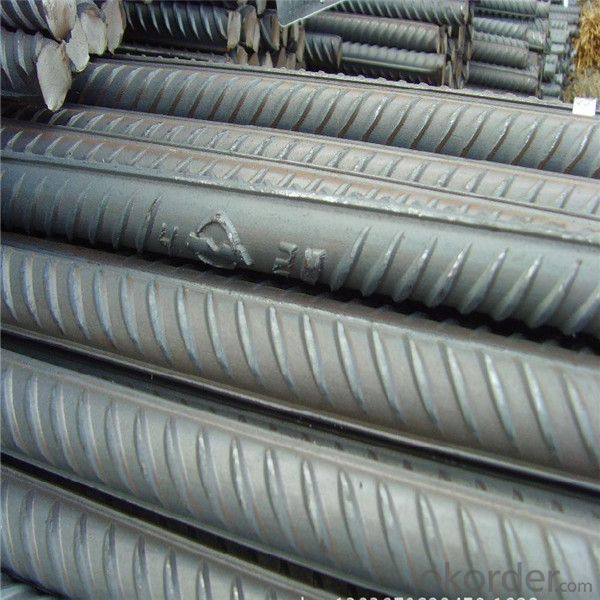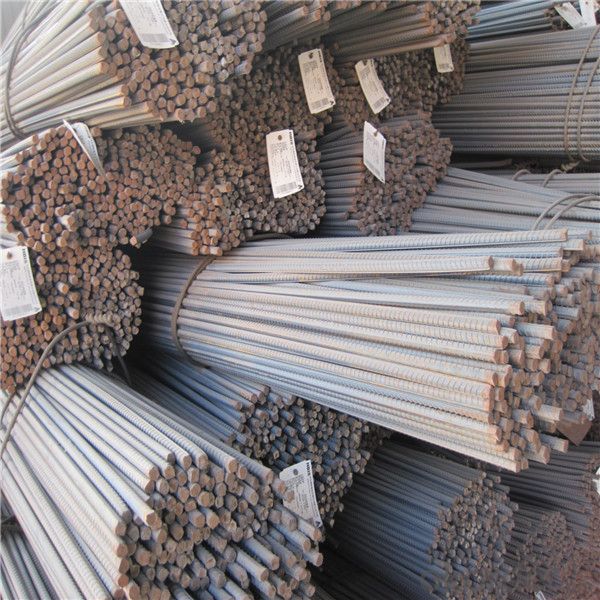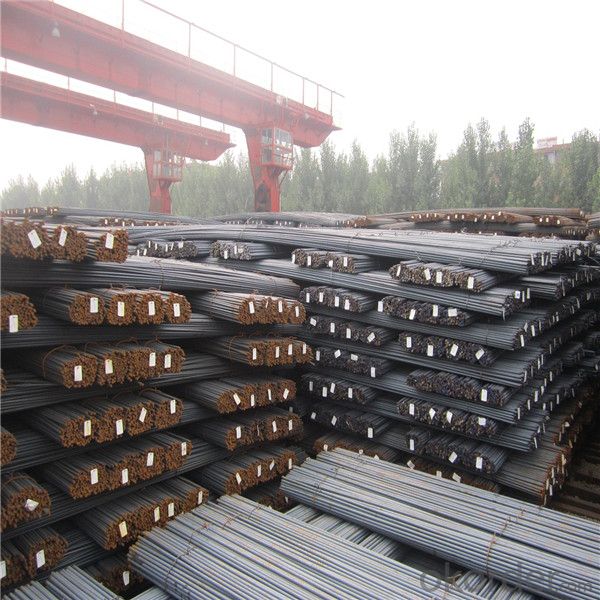Deformed steel bar 6-40 MM HRB 400 HRB 500
- Loading Port:
- Qingdao
- Payment Terms:
- TT OR LC
- Min Order Qty:
- 600 m.t.
- Supply Capability:
- 19452 m.t./month
OKorder Service Pledge
OKorder Financial Service
You Might Also Like
Item specifice
Rebar is common steel reinforcing bar, an important component of reinforced concrete and reinforced masonry structures.
It is usually formed from mild steel, and is given ridges for better frictional adhesion to the concrete.
To prevent such a failure, rebar is either deeply embedded into adjacent structural members, or bent and hooked at the ends
to lock it around the concrete and other rebars. This first approach increases the friction locking the bar into place while the
second makes use of the high compressive strength of concrete.
Most grades of steel used in rebar cannot accept welding; such as, to adjacent steel plates or as means to bind single pieces
of rebar together. However, special grades of rebar steel and welding rods make welding by expert welders possible.
Our Advantage:
High quality steel products from 1 class mills in China
Reasonable price
Professionalism of the products
On-time delivery
Complete documents and certificates
Sincere service to meet our clients' requirements
Product Description :
Chemical composition (%): | Steel | C | Si | Mn | P | S | Ceq | ||||
HRB335 |
0.25 |
0.80 |
1.60 |
0.045 |
0.045 | 0.52 | |||||
HRB400 | 0.54 | ||||||||||
HRB500 | 0.55 | ||||||||||
Mechanical properties | Steel | Rel/ MPa | Rm/ MPa | A/ % | Agt/ % | ||||||
≥ | |||||||||||
HRB335 | 335 | 455 | 17 |
7.5 | |||||||
HRB400 | 400 | 540 | 16 | ||||||||
HRB500 | 500 | 630 | 15 | ||||||||
Package: | Standard export packing or as customer's request | ||||||||||
Application: | Construction, building, bridge, road. ect | ||||||||||
Payment terms | 1).100% irrevocable L/C at sight. | ||||||||||
Delivery time | 15-30 days after receipt of L/C or deposit by T/T | ||||||||||
Features
1、Pure steel quality, stable chemical contents, small tolerance.
2、Constant Quality, good drawing performance.
3、High dimension accuracy degree, accuracy degree of Level C up to 80%, smooth surface, less scale, easy to be pickled.
4、Automatic bundling with 4 lines by Machine in tidy and good looks
5、Big high quality percentage, small coil percentage, and heavy coil weight for Hard Coil.
6、High sorbitizing percentage.


Packing:
In bundles, each bundle weight 3.5 tons. Load by container or by bulk verssel.


Our service
(1) We cooperate with famous factories with advanced equipment and well trained workers.
(2) We can provide factory price with trading company service.
(3) We continuously work on the improvement of our processes, guaranteeing consistently high standards
of quality to keep none compensation.
(4) We guarantee 24 hours response and 48 hours solution providing service.
(5) We accept small order quantity before formal cooperation.
(6) We deliver the agreed quality at the agreed time, reacting to changes in customer wishes in a flexible way.
(7) Due to our volume and selling power, we have excellent freight rates with shipping lines.
(8) We strive to always be fair and honest in our dealings with customers.
(9) We strive to work together with customers to achieve much more than we can achieve alone.
(10) Through our passion and commitment we aim to be a market leader in all our key markets. To maintain
our position as market leader we must continue to add value in all that we do.
FAQ:
1.Q: What's your MOQ(minimum order quantity)?
A: One full container, mixed acceptable .
2. Q: What's your packing methods?
A: Packed in bundle or bulk ..
3. Q: How can I buy CNBM products in my country?
A:Please send us an inquiry or email ,we will reply to you if there is distributor in your country
4. Q: Can we visit your factory?
A: Warmly welcome. Once we have your schedule, we will arrange the professional sales team to follow up your case.
5. Q: How long does it take to get the product if i place an order?
A:With the process of your requirements,we will pack and deliver in 3-7 days. If it is by sea shipment,it will take 15-45 days depending on different locations
- Q:Can steel rebars be cut to custom lengths?
- Yes, steel rebars can be cut to custom lengths.
- Q:What is the recommended maximum length of cantilevered steel rebars?
- The recommended maximum length of cantilevered steel rebars can vary depending on factors such as the specific application, load requirements, and design standards. It is important to consult structural engineers or relevant building codes to determine the appropriate maximum length for a specific project.
- Q:How do steel rebars affect the overall maintenance requirements of concrete structures?
- Steel rebars, being strong and durable, enhance the structural integrity of concrete structures. By providing reinforcement, rebars help in distributing the load and increasing the resistance to cracking and tension. This leads to reduced maintenance requirements for concrete structures as they become more resistant to wear and tear, environmental factors, and potential structural failures.
- Q:What is the relationship between steel structure and thread steel?
- Steel and thread steel are two entirely different concepts. A steel structure is a structural form of a structure, and the thread steel is the name of a material.
- Q:How do steel rebars affect the shrinkage and creep of concrete?
- Steel rebars can have a significant impact on the shrinkage and creep behavior of concrete. Shrinkage refers to the reduction in volume of concrete due to the loss of moisture during the drying process, while creep refers to the time-dependent deformation of concrete under sustained load. The presence of steel rebars helps to mitigate the shrinkage of concrete. As the concrete shrinks, the rebars, being much stiffer than concrete, resist this shrinkage and provide a restraining effect. This restraint reduces the overall volume change of the concrete and helps to minimize cracking that may occur due to shrinkage. Additionally, the tensile strength of the steel rebars allows them to distribute stress and prevent localized cracking, further reducing the impact of shrinkage on the overall performance of the concrete. In terms of creep, the presence of steel rebars can increase the creep deformation of concrete. This is because the rebars can introduce additional stress and strain into the concrete, leading to greater creep deflections. However, the effect of steel rebars on creep is generally considered to be minor compared to other factors such as the mix design, water-cement ratio, and curing conditions. It is important to note that proper design and detailing of the reinforcement layout can help minimize the impact of steel rebars on shrinkage and creep. Adequate spacing and cover of rebars, as well as appropriate reinforcement ratios, can optimize the performance of both the concrete and the rebars. Additionally, the use of supplementary cementitious materials like fly ash or silica fume can also help reduce shrinkage and mitigate the impact of creep. In summary, steel rebars play a crucial role in minimizing the shrinkage-related issues in concrete by providing restraint and distributing stress. While they may increase the creep deformation of concrete, their impact is generally minor compared to other factors. Proper design and detailing of the reinforcement can optimize the performance of both concrete and steel rebars in terms of shrinkage and creep.
- Q:What are the main uses of steel rebars?
- Steel rebars, otherwise known as reinforcing bars, serve as a crucial component in construction and civil engineering endeavors, granting robustness and steadiness to concrete structures. The primary applications of steel rebars encompass the following: 1. Reinforcement of Concrete: Steel rebars are strategically integrated within concrete structures to heighten their tensile strength. While concrete exhibits commendable resistance against compressive forces, it remains vulnerable in terms of tension. By incorporating rebars, the resulting composite material (reinforced concrete) is endowed with the ability to withstand both compressive and tensile forces, rendering it suitable for various applications such as building columns, beams, slabs, and foundations. 2. Enhancement of Structural Stability: Steel rebars play a pivotal role in elevating the structural stability of edifices and infrastructures. They facilitate the uniform distribution of loads across the structure, preventing the occurrence of cracks, sagging, or collapse. Through the reinforcement of concrete elements with rebars, structures become capable of enduring substantial loads, seismic activity, and other external forces. 3. Bridges and Highways: Steel rebars find extensive employment in the construction of bridges and highways. As bridges are routinely subjected to substantial loads and harsh environmental conditions, robust and durable reinforcement is imperative. Steel rebars ensure the longevity and structural integrity of these critical infrastructure projects. 4. Retaining Walls and Tunnels: Retaining walls serve the purpose of holding back soil or other substances, thereby preventing erosion. Steel rebars are commonly employed to reinforce these structures, enabling them to withstand the lateral pressures exerted by the retained material. Similarly, in tunnel construction, rebars bestow strength upon the concrete lining, ensuring stability and averting collapse. 5. Foundations: Steel rebars form an indispensable constituent in the construction of building foundations. They contribute to the even distribution of the structure's weight onto the ground, thereby averting the occurrence of settlement or sinking. Furthermore, rebars anchor the foundation to the ground, endowing it with stability against soil movement or seismic forces. 6. Pre-stressed and Post-tensioned Concrete: In the realm of pre-stressed and post-tensioned concrete construction, steel rebars are employed to introduce compressive forces into the concrete members. This technique elevates the structural performance by diminishing tensile stress, augmenting load-bearing capacity, and minimizing cracking. 7. Masonry Reinforcement: Steel rebars are also utilized to reinforce masonry structures such as walls, columns, and arches. By embedding rebars within mortar joints or cores, the overall strength and stability of the masonry system are enhanced, enabling it to withstand lateral loads and seismic forces. To summarize, steel rebars are indispensable in contemporary construction endeavors, furnishing concrete structures with strength, stability, and durability. By virtue of their capacity to resist tensile forces, they ensure the well-being and longevity of buildings, bridges, highways, tunnels, and other crucial infrastructure projects.
- Q:Can steel rebars be used in the construction of offshore oil and gas platforms?
- Yes, steel rebars can be used in the construction of offshore oil and gas platforms. Steel rebars are commonly used for reinforcing concrete structures, providing additional strength and durability. In the construction of offshore platforms, reinforced concrete is often utilized for the substructures, such as the foundations and caissons. Steel rebars play a crucial role in reinforcing these concrete structures to withstand the harsh marine environment, including corrosion and extreme loads.
- Q:How do steel rebars improve the structural integrity of a building?
- Steel rebars, also known as reinforcement bars, play a crucial role in enhancing the structural integrity of buildings. They are used in concrete construction to provide strength, durability, and resistance to various forces that a structure may encounter. One key way steel rebars improve the structural integrity of a building is by increasing its load-bearing capacity. When concrete is reinforced with rebars, it becomes more capable of withstanding heavy loads and forces such as those generated by gravity, wind, earthquakes, or even dynamic loads from human activities. The rebars act as a reinforcement network, distributing the load more evenly throughout the structure, preventing excessive deflection, and minimizing the risk of structural failure. Moreover, steel rebars improve the tensile strength of concrete, which is traditionally weak in tension. Concrete is great at bearing compression forces but lacks the ability to effectively resist pulling or stretching forces. By incorporating rebars into the concrete, the combination of materials works together to withstand both compression and tension forces more efficiently. This prevents cracks and fractures from propagating in the concrete, as the rebars act as a support system that holds the structure together. Another advantage of using steel rebars is their resistance to corrosion. Steel is highly durable and can withstand harsh environmental conditions, reducing the risk of degradation over time. This ensures the longevity of the building's structural elements and decreases the need for costly repairs or replacements. Additionally, steel rebars provide flexibility in design and construction. They can be molded into various shapes and sizes to accommodate specific structural requirements, making it possible to optimize the distribution of reinforcement where it is needed most. This flexibility allows architects and engineers to design buildings that are both aesthetically pleasing and safe, without compromising on structural integrity. In conclusion, steel rebars significantly improve the structural integrity of buildings by increasing load-bearing capacity, enhancing tensile strength, resisting corrosion, and providing design flexibility. By reinforcing concrete, they ensure that structures are better equipped to withstand various forces and maintain their stability and safety over time.
- Q:Can steel rebars be used in wastewater treatment plant construction?
- Yes, steel rebars can be used in wastewater treatment plant construction. Steel rebars are commonly used for reinforcement in concrete structures, providing strength and durability to withstand the harsh conditions present in wastewater treatment plants.
- Q:What are the guidelines for the proper spacing of steel rebars in columns?
- The guidelines for the proper spacing of steel rebars in columns are provided by various national and international codes and standards, such as the American Concrete Institute (ACI) and the British Standards Institution (BSI). These guidelines ensure the structural integrity and durability of the reinforced concrete columns. The spacing of steel rebars in columns is primarily determined by the following factors: 1. Concrete cover: The minimum concrete cover is specified by the codes to protect the steel reinforcement from corrosion and provide fire resistance. The spacing between rebars should be such that the required concrete cover is maintained uniformly around each rebar. 2. Rebar diameter: The size or diameter of the rebars influences their spacing. The codes specify the minimum clear spacing between adjacent rebars based on their diameter to prevent congestion and ensure proper concrete placement. 3. Column dimension: The size and shape of the column also play a significant role in determining the rebar spacing. Larger columns may require additional rebars compared to smaller ones to provide adequate reinforcement and resist the applied loads. 4. Load and design requirements: The design loads, including dead loads, live loads, and seismic loads, impact the spacing of rebars. The codes provide guidelines on the minimum amount of reinforcement required based on the column's dimensions and the anticipated loads. 5. Structural detailing: Proper detailing is essential to ensure the rebars are adequately anchored and lapped to develop the required bond strength. Guidelines for lapping lengths, anchorage lengths, and splices are provided in the codes to ensure the transfer of forces between the rebars and concrete. It is crucial to consult the specific code or standard applicable in your region to determine the exact guidelines for the spacing of steel rebars in columns. Additionally, it is recommended to engage a qualified structural engineer or designer to perform detailed analysis and design of reinforced concrete columns to ensure compliance with the appropriate guidelines and achieve a safe and efficient structural system.
1. Manufacturer Overview |
|
|---|---|
| Location | |
| Year Established | |
| Annual Output Value | |
| Main Markets | |
| Company Certifications | |
2. Manufacturer Certificates |
|
|---|---|
| a) Certification Name | |
| Range | |
| Reference | |
| Validity Period | |
3. Manufacturer Capability |
|
|---|---|
| a)Trade Capacity | |
| Nearest Port | |
| Export Percentage | |
| No.of Employees in Trade Department | |
| Language Spoken: | |
| b)Factory Information | |
| Factory Size: | |
| No. of Production Lines | |
| Contract Manufacturing | |
| Product Price Range | |
Send your message to us
Deformed steel bar 6-40 MM HRB 400 HRB 500
- Loading Port:
- Qingdao
- Payment Terms:
- TT OR LC
- Min Order Qty:
- 600 m.t.
- Supply Capability:
- 19452 m.t./month
OKorder Service Pledge
OKorder Financial Service
Similar products
New products
Hot products
Related keywords



























